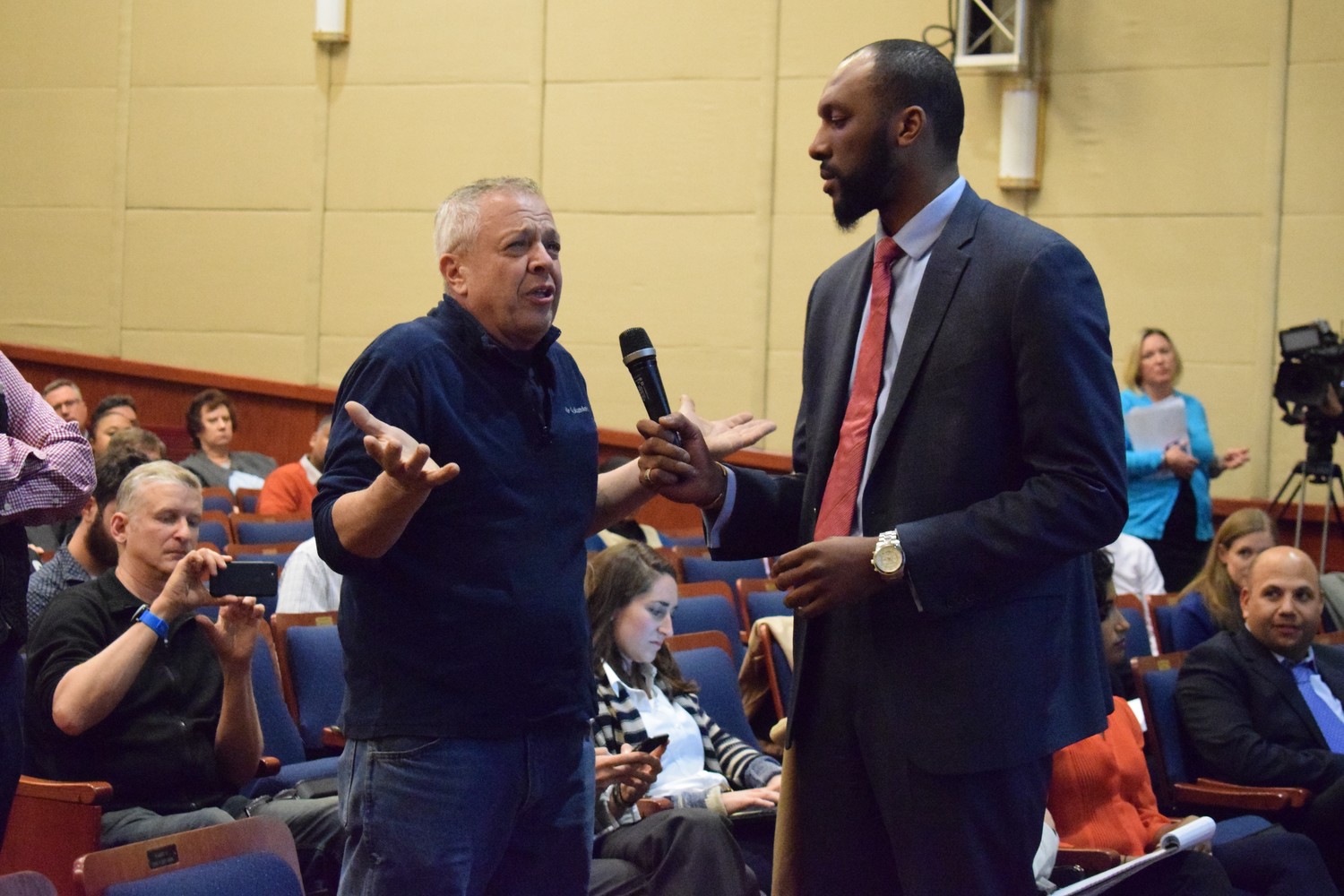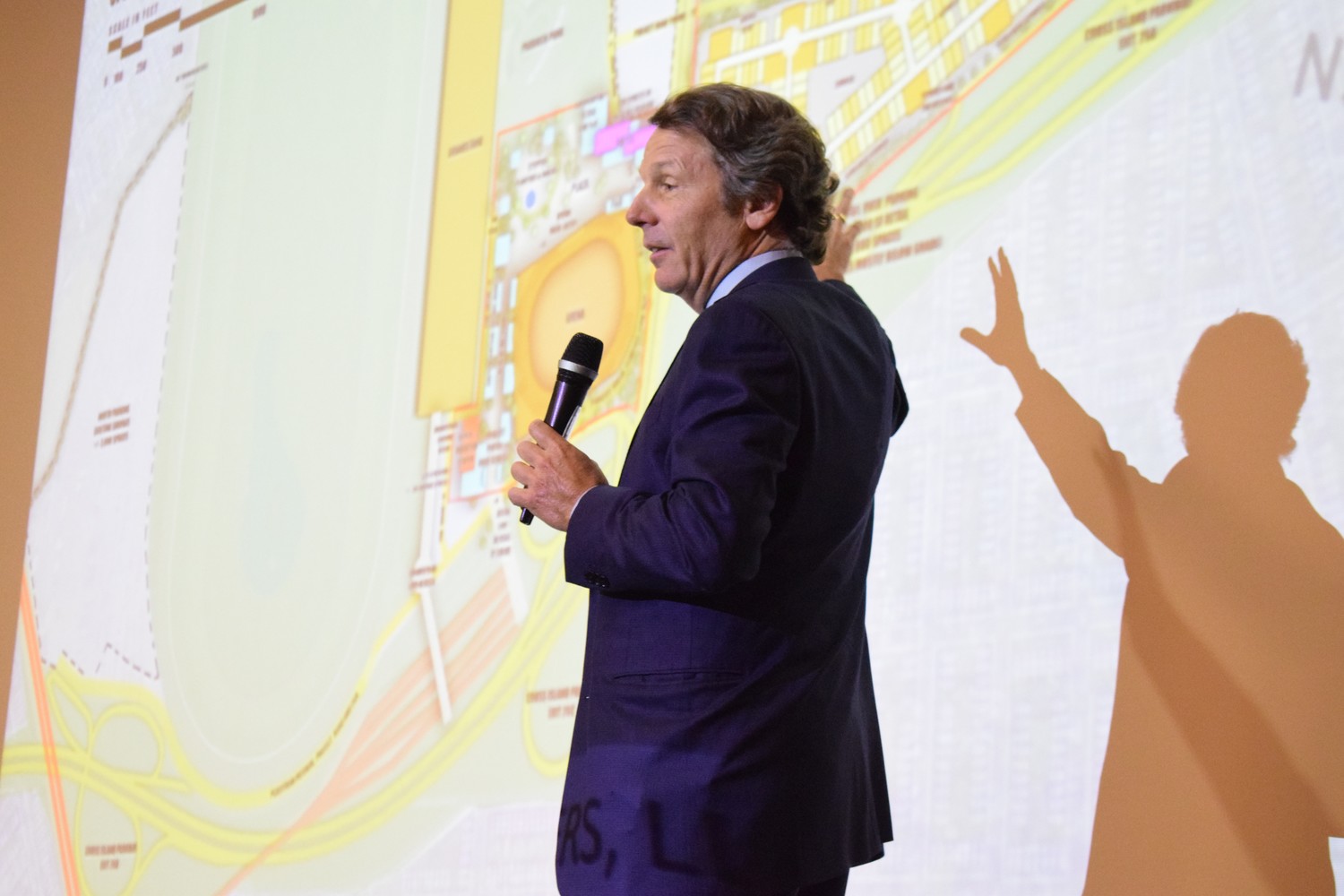Empire State Development chairs Belmont Q&A
Changes made to hotel, retail space and parking
The developers of Belmont Park outlined their plans during a question-and-answer session at Elmont Memorial Library, attended by residents of Elmont, Franklin Square, Floral Park and surrounding communities, on April 24. It was the first genuine public exchange since Empire State Development awarded the Belmont Park Arena project to the N.Y. Islanders last December.
Richard Browne, managing partner of Sterling Property Development, oversaw the question-and-answer session and explained changes made to the plan after having received feedback from residents and local officials. Among the biggest changes was moving the retail space away from the arena, he said.
“We got a lot of negative feedback from the retailers about having a multi-level retail space next to the arena,” Browne said.
Retailers had worried that the people who would tailgate outside the arena before games and would not shop at the retail center. The space has been moved to Site B, where the parking lots were originally proposed.
With the larger space, Browne said, the retail center would no longer be multi-level, helping to avoid disruptive construction work near the Floral Park homes that neighbor the site. With the retail space replacing the parking lot, and a smaller sub-level lot proposed instead, residents said they worried that the parking lots might not accommodate maximum attendance at the 18,000-seat arena.
While Metropolitan Transportation Authority Chairman Joseph Lhota expressed skepticism in the past over an upgrade to the Long Island Rail Road station in Belmont, Holly Leicht, from ESD, said developers were in ongoing talks with the MTA to make that happen.
The developers also announced changes made to the hotel, whose original 270-foot height and location near a local school worried residents. “We’re moving the hotel from its original spot, spreading it out more and bringing the height down,” Leicht said.
The proposed hotel is now located near the arena and capped at 150 feet tall — around 10 stories. It would no longer tower above Hempstead Turnpike and cast a shadow over the track and grandstand, which concerned New York Racing Association officials at Belmont.
Browne also repeated that the substation to power the arena would not be located near the local school, as residents had feared.
Floral Park resident Brenda McDonald, whose home borders Site B, was worried about security and parking problems that might arise because of the arena project. Her home is next to where the proposed Community Space and Innovation Center was originally located. Browne said that the center would be moved away from that spot to one near the arena to keep crowds away from neighboring homes.
Leicht added that developers had toured Floral Park neighborhoods several times, and were looking into whether parking permits could be given to residents living next to the proposed arena. Browne added that there would be 24/7 security at the site, noting that the arena is a billion-dollar investment.
“It will have more enhanced security than anything that you’ve ever seen here,” he said.
Lingering worries
Despite changes to the development plan, many residents said they were not sold on the project. They continued to express concerns about traffic and whether the arena would succeed in bringing economic growth to the Elmont and Floral Park communities.
Union leaders, like Kevin Smith of Local 176 Licensed Ushers and Ticket Takers, said most arena workers should be unionized. Developers said that while there was no formal agreement to use organized labor for the project, they do plan to work with the unions.
“We’re looking to recreate our success at Citi Field, where 43 percent of the work was done by the local workforce,” Browne said.
A handful of local residents said they wanted the Islanders to move to a newly proposed stadium in Ronkonkoma instead of Belmont.
Local community activist Tammie Williams, of the Belmont Park Community Coalition, said that the development of Belmont Park did not have proper community input until after the project for an arena was chosen. “Pretending to listen to the community now, with choreographed ‘sessions’ that answer only the questions ESD finds convenient, does not address any concerns about the project, or the process that is in place,” Williams said.
She said the financing for the Barclays Center in Brooklyn, the Islanders’ current home, is one step above junk-bond status, and that Elmont residents could not afford to take such a risk.
The Barclay Center’s bonds are cur-
rently rated BBB-.
Leicht was also open to the idea of signing an agreement not to allow a casino at Belmont, which residents said they feared could happen if the arena proposal were to fall through.
ESD and New York Arena Partners LLC will continue to meet with local residents and officials to update their development plans. The Environmental Impact Study is under way and scheduled to be completed by next spring.
The arena is to be finished in time for
the Islanders’ first home game in the fall
of 2021.

 45.0°,
Partly Cloudy
45.0°,
Partly Cloudy 







